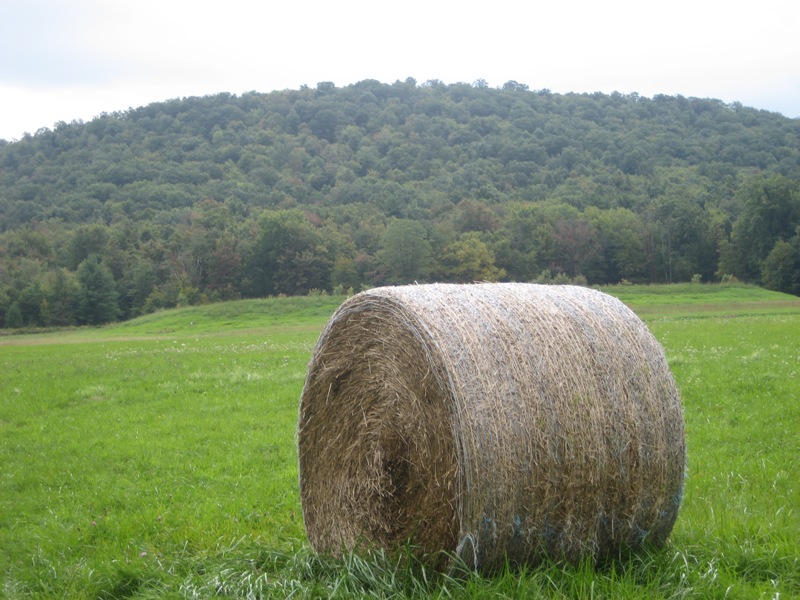
(Source: Pennsylvania State University. Agricultural Safety and Health)
Use the following format to cite this article:
Safety Recommendations When Baling and Handling Round Bales. (2012) Farm and Ranch eXtension in Safety and Health (FReSH) Community of Practice. Retrieved from http://www.extension.org/pages/64301/safety-recommendations-when-baling-and-handling-round-bales.
When baling and handling large round bales, you must recognize and understand potential hazards and follow the manufacturer’s operating recommendations for each piece of equipment you use.
Using a Round Baler
The round baler is a complex machine with multiple moving parts, and an entanglement incident could lead to costly repair bills, injury, or death. Prior to using the baler each season, you must:
- thoroughly inspect it,
- make any needed repairs, and
- review all of the safety precautions in the owner’s manual.
The size and rated power of the tractor you use with your baler must meet the manufacturer’s requirements for towing and powering the baler.
Safety Recommendations
- Make sure that safety locks are in place when working on the baler while the bale chamber is open.
- When operating the baler, do not leave the tractor seat until the power take-off (PTO) is disengaged and all moving parts have stopped.
- Ensure that all the original shields are in place on the power shafts and other moving parts of both the tractor and baler.
-
Because balers produce flammable dust and are susceptible to overheating due to friction, equip your tractor with a 10-pound dry chemical (ABC) fire extinguisher.
-
Eject the bales at an angle perpendicular to the slope to reduce the risk of a bale rolling down the incline.
-
When baling on uneven or hilly terrain, travel slowly and avoid holes and drop-offs. A round baler has a high center of gravity and could tip sideways if a wheel goes into a ditch or hole.
-
Avoid sharp turns with a baler because the tractor wheels might hit the tongue of the baler.
- Refer to the owner’s manual of the baler for additional safety information related to the machine you are using.
Handling Bales
Many producers move bales in the field with front-end loaders. The recommended practice for moving bales with a front-end loader is to remove the bucket and use an attachment designed to handle round bales, such as a grapple hook or bale spear. Using a grapple hook or spear on your front-end loader reduces the potential for the bale to roll back onto the loader arms or operator. Click here to watch a video by Mississippi State University about the danger of lifting unsecured loads with a front-end loader.
Be certain that both the tractor and the attachment are able to safely handle the weight and size of your round bales. The lifting mechanism used to move the bales should have a working load rating that exceeds the size of the bales.
The center of gravity on a tractor changes when it is carrying a bale. Producers tend to lift the load to increase visibility. This action raises the center of gravity and places the tractor at increased risk for a side overturn. The risk of a side overturn also increases when traction is lost because the tractor is operating on rough terrain or wet ground.
When using a rear-mounted three-point lift to move round bales, do not lift bales too high. The center of gravity could shift to the rear of the tractor and cause the front of the tractor to rise. If the front of the tractor rises too much, the front tires lose stability, and steering is impaired. Hauling bales simultaneously with a front-end loader and rear-mounted attachment can reduce the stability problem, but you must take care not to exceed the weight limit for the loader tractor’s tire capacity.
Safety Recommendations
-
Avoid overhead wires when you are moving bales with a front-end loader. Keep the bale close to the ground.
-
Use additional weight (within the load capacity of the tires) on the front or rear end of the tractor to ensure stability.
-
Relieve the hydraulic pressure before disconnecting all hydraulic lines. Examine the lines for leaks and malfunctioning parts.
-
When moving bales, use a tractor that is equipped with a rollover protective structure (ROPS), and always buckle the seat belt.
Hauling Bales
Specialized bale wagons and trailers that carry multiple bales at a time can save time and reduce the risk of overturns and of overloading a tractor’s hydraulic system.
Safety Recommendations
- When using a wagon or trailer to haul bales, choose a tractor that can maneuver and stop a wagon or trailer carrying the weight of the bales.
- Ensure that the wagon or trailer is properly hitched to the tractor’s drawbar by using a safety pin and a safety chain.
- Properly secure the bales on the wagon or trailer by using straps that have a tensile strength of one-and-half times the weight of the load.
- When transporting round bales on a public roadway, remember to follow all traffic laws related to wide loads. The trailer or wagon should be highly visible and equipped with a slow-moving vehicle (SMV) emblem, reflectors, and warning lights.
Use the following format to cite this article:
Safety Recommendations When Baling and Handling Round Bales. (2012) Farm and Ranch eXtension in Safety and Health (FReSH) Community of Practice. Retrieved from http://www.extension.org/pages/64301/safety-recommendations-when-baling-and-handling-round-bales.
Sources
Grisso, R., Cundiff, J., Stone, B., and Smith, R. (2002) Large round bale safety. Virginia Cooperative Extension. Retrieved from http://www.pubs.ext.vt.edu/442/442-455/442-455_pdf.pdf.
Grisso, R., Fike, J., Ohanehi, D. & Perumpral, J. (2014). Management Tips for Round Bale Hay Harvesting, Moving, and Storage. Virginia Cooperative Extension. Retrieved from http://pubs.ext.vt.edu/442/442-454/442-454.html.
Reviewers, Contributors, and Summarized by:
Linda M. Fetzer, Pennsylvania State University – lmf8@psu.edu


